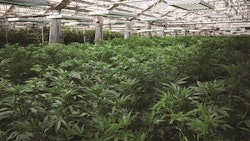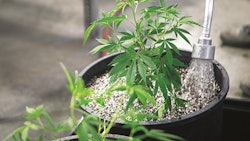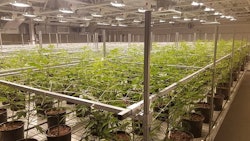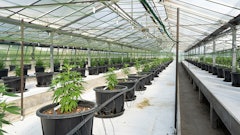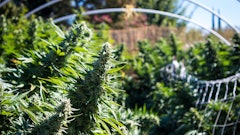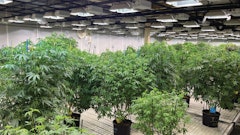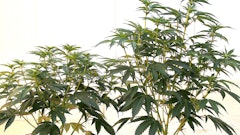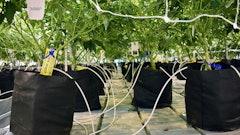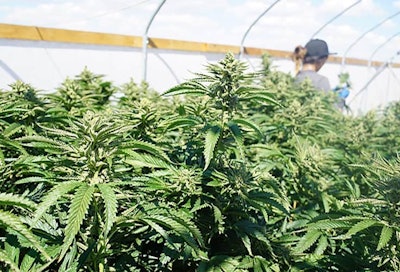
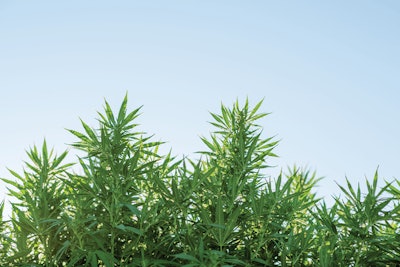
Outdoor cultivators face a plethora of challenges that are unique to the sun-grown method. While growers working in controlled environments can customize conditions, outdoor farmers are at the mercy of nature’s whims. Planning ahead and being ever vigilant are keys to a healthy outdoor harvest.
With that in mind, here are five common problems that outdoor cannabis farmers can encounter—from unique pest problems to extreme weather—and tips on how to deal with them.
Common problem #1: Heat waves.
As explained previously in part one of this three-part series, “6 Greenhouse Problems and How To Solve Them,” extreme temperatures from summer heat and nearby wildfires can impact crop health and quality. TIP 1 While outdoor farmers in these geographic regions are limited in what they can do to cool their crop, one potential solution for dealing with high temperatures is using shade cloths—cloth screens used to reduce the amount of light a canopy receives. Different grades of shade cloth block out varying levels of sunshine (e.g., 10% cloth blocks out 10% of sunlight). Growers can make provisions to shade outdoor plants when temperatures reach detrimental levels (more than 110 degrees F), or when ash from forest fires rain down on sticky buds.
Sunshine cloth is usually utilized to minimize sun exposure to plants, but it will also prevent a majority of airborne ash from settling on the plants. TIP 2 When selecting a sun cloth to purchase, growers should ask vendors questions, including (but not limited to): What is the cloth’s UV susceptibility? What is its typical lifespan? How often do customers swap out old cloth for new? What is the cloth’s weight? The last one is important to determine if the cloth too heavy to raise by hand or for the mechanical system a grower plans on using.
TIP 3 If heat continues to be a problem under the sunshine cloth, then growers can set up fans at the end of each “tunnel” to increase airflow in the canopy, therefore removing heat from near the leaf surface.
Common problem #2: Damage from budworm.
Each year before and during harvest, I get calls from outdoor growers inquiring how to get rid of budworm caterpillars (typically tobacco budworms). Budworm-infested buds generally exhibit chewing damage. An infestation starts with a female moth laying an egg on a cannabis plant. The larvae or caterpillars emerge (eclose) from the egg and feed on the developing cannabis buds. The tissue that has been fed upon may die. The caterpillar also may defecate inside the bud, which may cause the bud to mold from the inside out. Most cultivators only know they have a caterpillar infested crop once the bud structure falls apart at harvest.
When I receive calls related to budworms, my answer is always the same: TIP 4 The best time to observe and catch the caterpillars is in the evening. TIP 5 When scouting for budworms, growers should thoroughly inspect the plants and buds, and remove and kill all caterpillars and infected buds.
While Spinosad may be the recommended insecticide to control tobacco budworm, it is not an approved insecticide for cannabis in many jurisdictions. TIP 6 Therefore, growers can apply* Bacillus thuringiensis sub. kurstaki (aka Btk) before plants are in bud. Btk is a naturally occurring bacterium that is safe to humans and pets. Btk is a stomach poison, so the tobacco budworm caterpillars must ingest the material (active ingredient) to be negatively affected. TIP 7 In addition, the timing of applying Btk is important, as the insecticide is more effective on young or small caterpillars than mature or larger caterpillars. (*Growers should always check that the product being applied is approved for cannabis use by state regulators.)
Dr. Raymond Cloyd, professor of entomology and extension specialist at Kansas State University, notes that Btk may not be effective in managing populations of tobacco budworms later on in the growing season when buds are present because the caterpillars may not ingest enough of the active ingredient to be controlled.
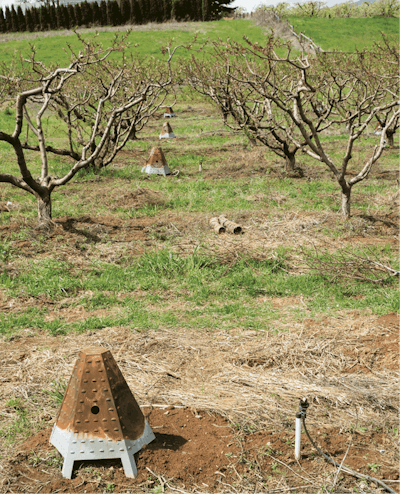
Common problem #3: Poor growth.
A balanced nitrogen, phosphorus and potassium (NPK) nutrient program and pH conducive to healthy growth are needed for quality cannabis, and that’s whether it is grown in a container fed with fertilizer salts, or in field soil that has been amended. It is best that growers know both the NPK and pH of the growing medium prior to introducing plants to maximize growth and health. TIP 8 Whenever possible, growers should take soil samples to a lab to get an unbiased, accurate measurement on both the composition and the pH of the soil. Knowing the composition and pH of the soil will help to determine what amendments to add to a depleted soil.
Organic grape farmers often use waste byproduct from the crushing process to make compost that feeds the soil in which the next grape crop is grown. Other farmers use alfalfa as a cover crop to till back into the soil to increase the soil’s nitrogen content. TIP 9 While many jurisdictions’ cannabis waste laws won’t allow cannabis farmers to use cannabis waste in a compost mix, cover crops can be a good soil remediation tool for many outdoor farmers.
TIP 10 For information on what NPK and pH levels to target, refer to the Nutrient Matters series from researchers at North Carolina State University in Cannabis Business Times. (“New Research Results: Optimal pH for Cannabis,” “Balancing the Nutrient Equation in Cannabis Cultivation”)
Common problem #4: Early winter storms.
As the climate changes and becomes more volatile, growers must learn to expect the unexpected, such as some geographic locations having fierce hailstorms or unseasonably early snowstorms.
Last growing season, I saw social media posts in which outdoor farmers dealt with both situations: plants beaten down and destroyed by hailstorms, as well as snow-covered plants a few days before harvest. In Canada, I saw a video of a grower harvesting outdoor plants in an October sleet storm that was earlier than any previous storm on record.
TIP 11 With that in mind, outdoor growers in areas prone to extreme winter conditions may want to proactively design and construct frames that allow them to easily cover plants in the event of unseasonably cold weather and/or extreme weather conditions.
While this is not a solution for cannabis farmers, Napa Valley vineyards have 20-foot wind machines/air movers in them; these are essentially 20-foot-tall round poles with two propellers attached to motors on top. Among the grape vines are smudge pots (also known as orchard heaters), oil-burning devices used to prevent fruit trees from freezing. These smudge pots can be filled with diesel fuel and set ablaze to keep crops warm. The smudge pots create heat, and the propellers move the warm air throughout the vineyard. While tempting to try, the smoke from the burning fuel could contaminate cannabis crops.
Temperatures are not likely to get so low for so long before a cannabis harvest that it would require the use of heaters, but weather patterns can be problematic. TIP 12 Cannabis growers can use quick-rising hoop houses to protect their crops from snow and/or ice storms. Covering crops is a time-tested solution used in other large-scale produce industries, including blueberry farms.
Common problem #5: Watering.
As mentioned in the previous greenhouse article, growers must prioritize the maintenance and upkeep of the watering and fertigation system. TIP 13 In outdoor grows, winter and spring are early opportunities to fix, address or upgrade watering and fertigation systems. Clogged drippers, broken lines, major leaks, etc., are all problematic and are best addressed when no plants are at risk. TIP 14 Growers can use a one-part hydrogen peroxide, 10-part water solution to clean drippers and feed lines.
As global warming continues to be a growing problem, outdoor farmers, more than ever, need to expect the unexpected and the never-thought-of. Being able to quickly problem-solve and adapt to constantly evolving climate changes can be the difference between a year’s worth of work being lost or harvested.








